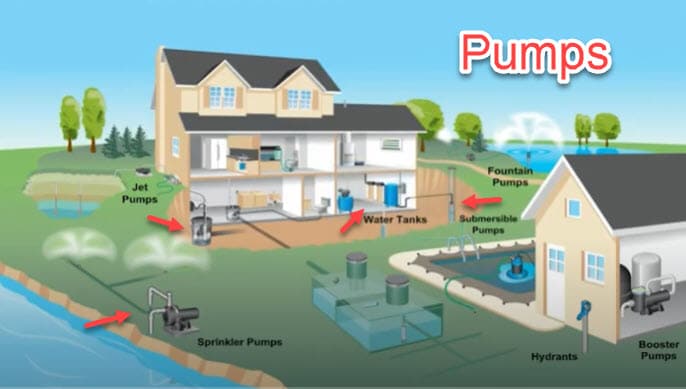Residential pumps in Central Florida typically provide water to your in-ground sprinkler system from well water, household water or an open water source. Sprinkler pumps move water from a water source to a system that moves water to various locations, such as a sprinkler system. Sprinkler pumps should be used with a water source that has a depth to water of 25 feet or less key considerations. The construction typically cast iron or thermoplastic gallons per minute. How much water the pump will move and horsepower, which is the horsepower of the pump and performance optimal performance for a well and an in-ground sprinkler system, is achieved at 30 psi when choosing or repairing a sprinkler pump in Orlando.
Pump and Well Considerations
You want to consider five parameters:
- What is the wonder source?
- What is your suction lift?
- What is your water demand for?
- What is the horsepower of the pump required?
- What pipe size should you use when it comes to a water source? Meaning are you going to get it from either well water, household water or an open water source such as a lake or pond?
When determining your suction lift, you must measure the vertical distance of a pump. Above the water source, remember that maximum vertical lift is at 25 feet. Then what is your water demand? What are the number of sprinkler heads you’ll have in your system? What are the gallons per minute required by each sprinkler head?
To calculate this you’ll multiply the number of sprinkler heads by gallons per minute for each head to determine the total demand. Remember that optimum performance is achieved at 3 PSI. Then you’ll determine the needed horsepower for the pump to do this, you’ll consider the depth to water source and the capacity required, which is the gallons per minute at 30 PSI. Finally, what pipe size should you use? The suction pipe should be the same size or larger than the discharge pipe size of the pump things you’ll need will be a check valve or a foot valve PVC cement, PTFE pipe thread sealant.
You’ll also want to be sure that you have these tools available, screwdriver, adjustable pliers, a tape measure and hacksaw. Lets talk about well products. These are going to be jet pumps and 4 inch, submersible well pumps. These bring clean usable water into your home from a well water source. Pressure tanks are used to store water until you need to use it.
Jet Pumps
Jet pumps are mainly used for household water supply from a well, drive point system or open water source. Jet pumps are used in conjunction with the pre-charged pressure tank. Key considerations for jet pumps are the depth to water, power supply and horsepower for deep-well applications. The depth of water is typically greater than 25 feet in shallow well application. Depth of water should be 25 feet or less when it comes to power supply. Most jet pumps are dual voltage and can be run with either a 120-volt or 240-volt power supply. When replacing a deep well pump, you must match the horsepower of the current pump to maintain optimal performance. When it comes shallow wells, you must match or increase the horsepower of your current pump to maintain or improve 
Some other considerations: an ejector kit is required (also known as a jet package) for proper operation of a convertible jet pump. Without a jet, the pump would only move water. It would not build enough pressure to turn off. Do you need a pressure switch? Jet pumps turn on and off by a device called the pressure switch This is typically included with the pump. The pressure range indicates that what pressures the pump will turn on and off. Also, you’ll need to install a foot valve and/or check valve in a shallow installation.
Shallow Well Pumps
Remember a shallow well setup is applicable when the depth to water is 25 feet or less. The first thing that happens is the pressure gauge measuring water pressure. Entering the home from the water storage tank drops from its usual 50 psi down to 30 psi. This drop in pressure triggers the pressure switch inside the pumps motor that tells the pump that more water is needed to meet pressure and so begins a pump cycle in doing so.
Water flows up through the well case from the well point past the foot valve and strainer up the pipe and pushed into the tank and fed into the house. The bladder inside the tank is filled again to pressure and the household has the water it needs. Remember a deep, well setup is applicable when the depth of water is 25 feet or more. The first thing that happens is the pressure gauge measuring water pressure from the home to the storage tank drops from its usual 50 psi down to 30 psi. This drop in pressure triggers the pressure switch inside the pumps motor that additional water is needed, and so the pump cycle begins. Water is pushed to the deep well down one pipe and then pulled back up from the ground and into another well pipe. When water reaches the pump and the tank. It is both fed to the house and refills the tank bladder so that the tank can regain desired pressure.
In addition, there are two types of well pumps: a single pipe and a double pipe. A double pipe deep well will require a four-inch, well casing and a well seal. A single pipe deep well can be managed in either a 2 inch or three inch well casing and leather cup seals.
For a typical jet pump installation you’ll want to have the following materials and tools:
- Check valve
- PVC cement.
- Tank cross
- Discharge T
- Well seal
- PTFE pipe thread sealant
- Screwdriver
- Adjustable wrench
- Hacksaw
- Pipe wrench
Submersible Deep Well Pumps
A 4-inch submersible well pump is used for household water and irrigation system supply. It is also used in conjunction with pre-charged pressure tanks. If used solely for lawn sprinklers a pump start is often used in place of a pressure tank. Key considerations for a submersible pump are size of well casing, depth to water, and horsepower. You must have a minimum diameter of 4-inch well casing for the pump with the depth to water of 400 feet or less. You want to replace the existing pump with the same horsepower and pump gallon series when choosing your 4-inch submersible pump. You want to consider existing wiring as well as horsepower In a 2 wire setup the pump includes the start controls in the motor. If the wiring goes from the pressure switch directly to the pump it’s a 2 wire. Although referred to as “2 wire” these pumps actually have three wires as one is the ground wire. Then there are three wire 4 inch submersible pumps. These include the control box, which is mounted above ground. These three wire pumps have the control box between the pressure switch and the pump. These pumps will have four wires because one is a ground wire.
Replace an existing pump with the same horsepower in gallon series. The greater the depth of water, the higher the horsepower required. This is how a 4” submersible well pump works in a residential application: The pressure gauge measuring water pressure between the submersible well and the tank T drops, from its usual 60 psi down to 40 psi. In this situation, the water system is using a control box. The pressure switch triggered by the low pressure kicks off a signal to the box that pressure has fallen and more water is required. The control box then sends a signal down to the well to engage the pump. Now the pump can push water up to the residence where it is fed to the tank into the house. The tanks bladder refills, regaining pressure and simultaneously the house has its water needs met.
When installing a typical 4-inch submersible well pump you will want to make sure you have certain materials such as:
- PVC or steel pipe hose clamps
- pipe fittings
- a relief valve
- a wheel cap
- a tank tee
- check valves
- Pressure switch
- Pressure gauge
- surge protector
- well seal or pitless adapter
- splice kit tools.
Tools needed:
- screwdriver
- pliers
- hammer
- electric cable
- ohm and volt meter
- small weight
- nylon string
- electrical tape
- hacksaw
- quarter inch nylon safety rope
- knife
- block and tackle
- two pipe wrenches
- heat gun
- wire stripper
- adjustable wrench
Pressure Tanks
Pressure tanks store water under pressure from a well system. Increased water storage capacity extends the life of your pump by reducing the number of times the pump must cycle to supply water to your home. Key considerations for pressure tanks are that they can be vertical or they can be horizontal construction and then there’s pre-charged versus standard tank. Vertical tanks are ideal for applications with a smaller footprint. Horizontal tanks are ideal for applications with height restrictions. When it comes to construction, tanks are made of heavy gauge steel and have a tough appliance like finish, that extends the life of the tank. Standard tanks are not pressurized because as the pump pushes water into the tank it compresses the existing air pocket, thereby pressurizing the tank. The air volume control, helps to maintain the air pocket in the tank. Once pressurized, standard tanks are known as air over water. The air presses down on the water, causing it to stay pressurized. Pre-charge tanks contain a bladder. The bladder or diaphragm stops the water from absorbing the air out of the tank.
You have two main considerations. First, if you have an existing pressure tank, is it pre charged and what’s its size? All pre charge tanks will have a single pipe connection. In harsh or extreme conditions consider using a galvanized standard tank. As far as size is concerned, at a minimum the tank needs to hold the amount of water the pump is capable of pumping in one minute. A bigger tank is always better. The bigger the tank, the fewer times the pump cycles, thereby extending the life of the pump. When installing a tank, you need to have some materials and tools:
1.pressure switch
2.pressure gauge
3.pressure relief valve
4. tank T fittings
5. check valve
6. tank installation kit
7. air volume control kit
8. PVC glue
9. PTFE pipe thread sealant
10. screwdriver
11. adjustable pliers
12. hacksaw
13. tape measure
Conclusion
Every day, water flows into and out of our homes in several different ways: fresh water for our kitchens bathrooms and sprinklers – comes in through city water lines or from a private water well. Many homes here in the Orlando area also have reclaimed grey water that is only used to water the lawn and landscaping. Whatever the source, It’s important to remember that water in Central Florida is a finite resource that must be managed with care.



